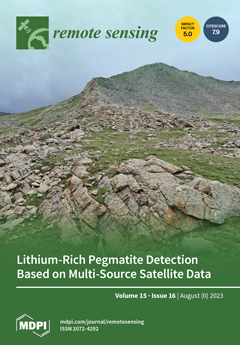Grassland ecosystems are an important component of global terrestrial ecosystems and play a crucial role in the global carbon cycle. Therefore, it is important to study the carbon dioxide (CO
2) process in the Middle Tien Shan grassland ecosystem, which can be
[...] Read more.
Grassland ecosystems are an important component of global terrestrial ecosystems and play a crucial role in the global carbon cycle. Therefore, it is important to study the carbon dioxide (CO
2) process in the Middle Tien Shan grassland ecosystem, which can be regarded as a typical representative of the mountain grasslands in Xinjiang. Eddy covariance (EC) and the global carbon fluxes dataset (GCFD) were utilized to continuously monitor the Middle Tien Shan grassland ecosystem in Xinjiang throughout the 2018 growing season. The findings revealed notable daily and monthly fluctuations in net ecosystem exchange (NEE), gross primary productivity (GPP), and ecosystem respiration (Reco). On a daily basis, there was net absorption of CO
2 during the day and net emission during the night. The grassland acted as a carbon sink from 6:00 to 18:00 and as a carbon source for the remaining hours of the day. On a monthly scale, June and July served as carbon sinks, whereas the other months acted as carbon sources. The accumulated NEE, GPP, and Reco during the growing season were −329.49 g C m
−2, 779.04 g C m
−2, and 449.55 g C m
−2, respectively. On the half-hourly and daily scales, soil temperature (Ts) was the main contributor to CO
2 fluxes and had the greatest influence on the variations in CO
2 fluxes. Additionally, air temperature (Ta) showed a strong correlation with CO
2 fluxes. The grassland ecosystems exhibited the strongest CO
2 uptake, reaching its peak at soil temperatures of 25 °C. Moreover, as the air temperatures rose above 15 °C, there was a gradual decrease in NEE, while CO
2 uptake increased. The applicability of GCFD data is good in the grassland ecosystem of the Middle Tien Shan Mountains, with correlations of 0.59, 0.81, and 0.73 for NEE, GPP, and Reco, respectively, compared to field observations. In terms of remote sensing spatial distribution, the Middle Tien Shan grassland ecosystem exhibits a carbon sink phenomenon.
Full article





